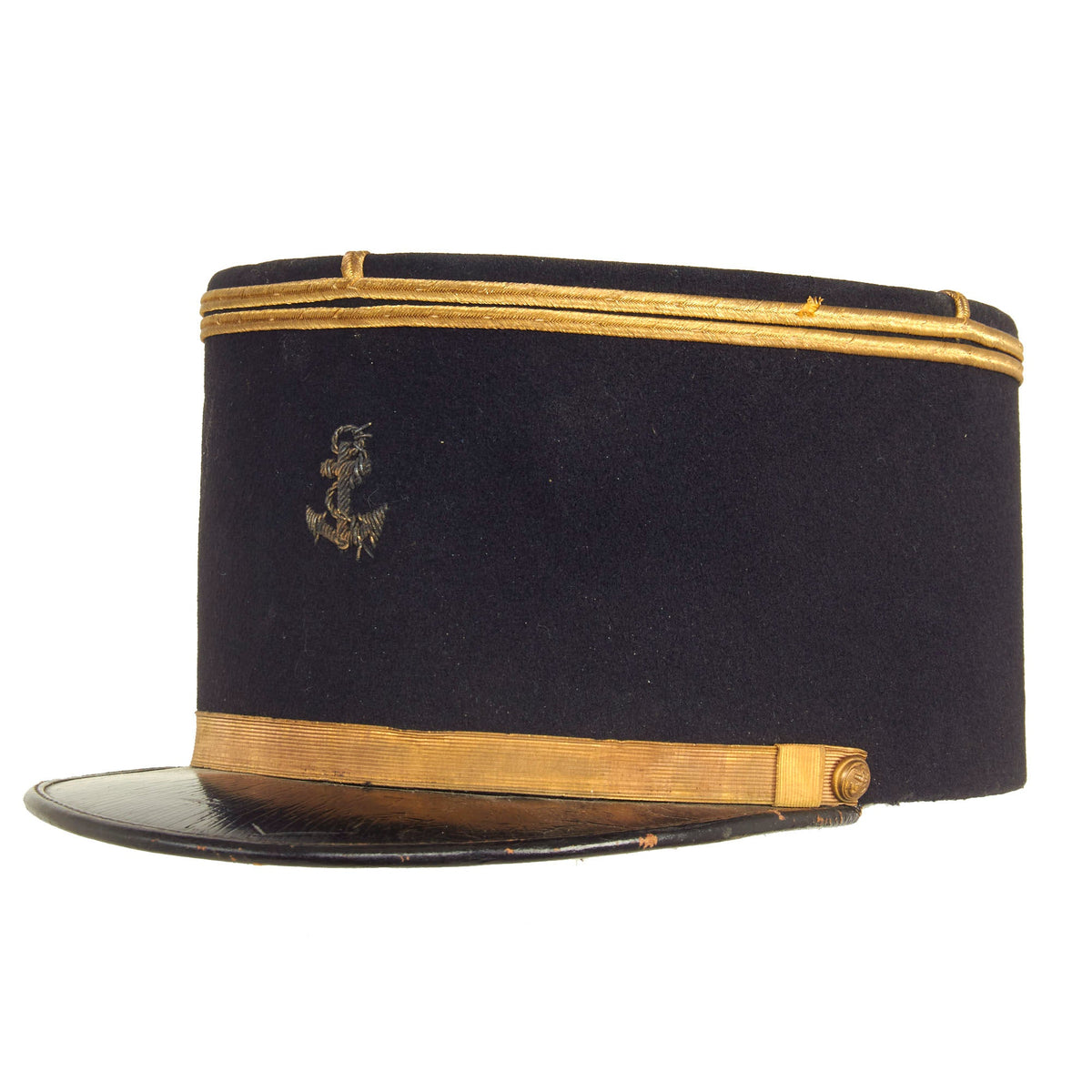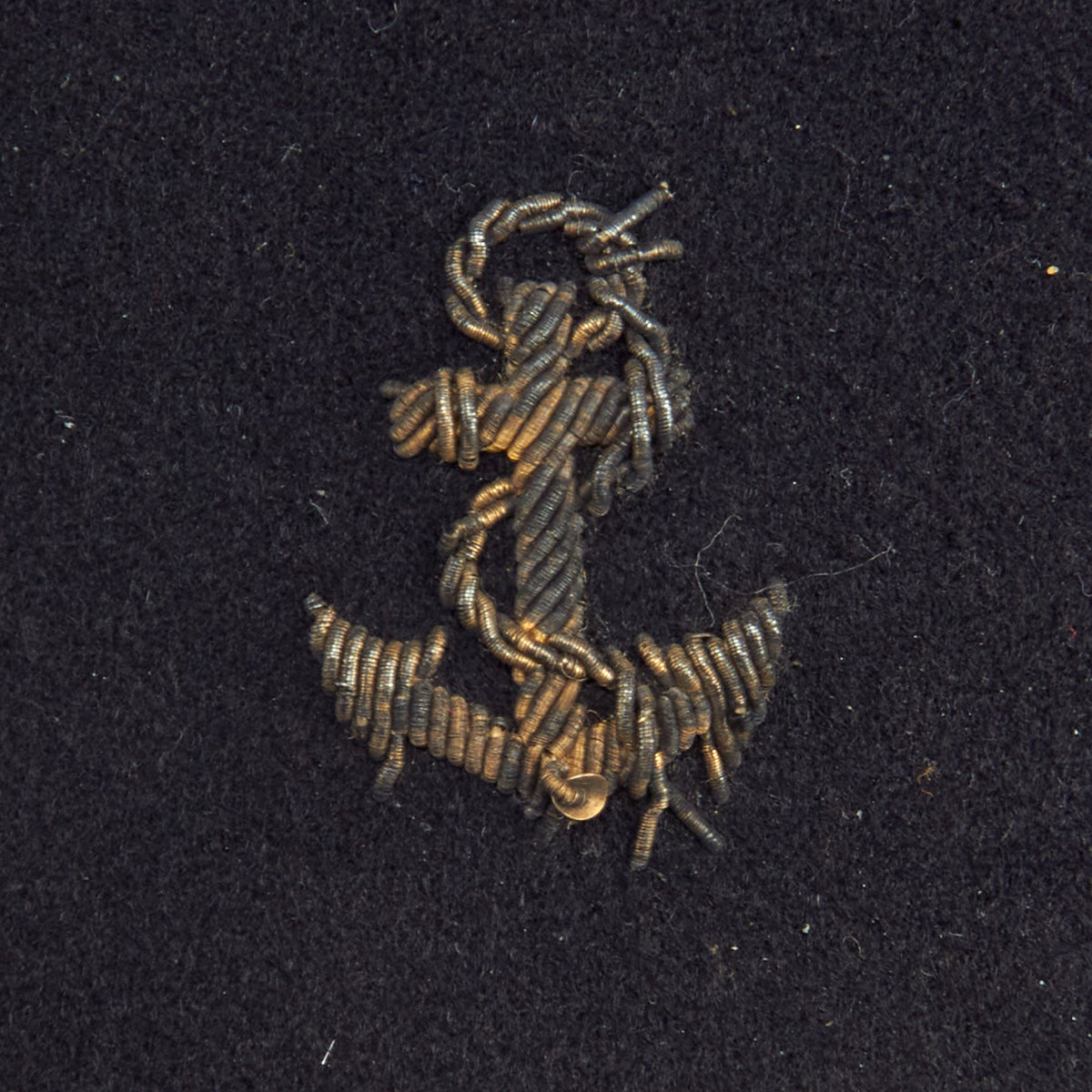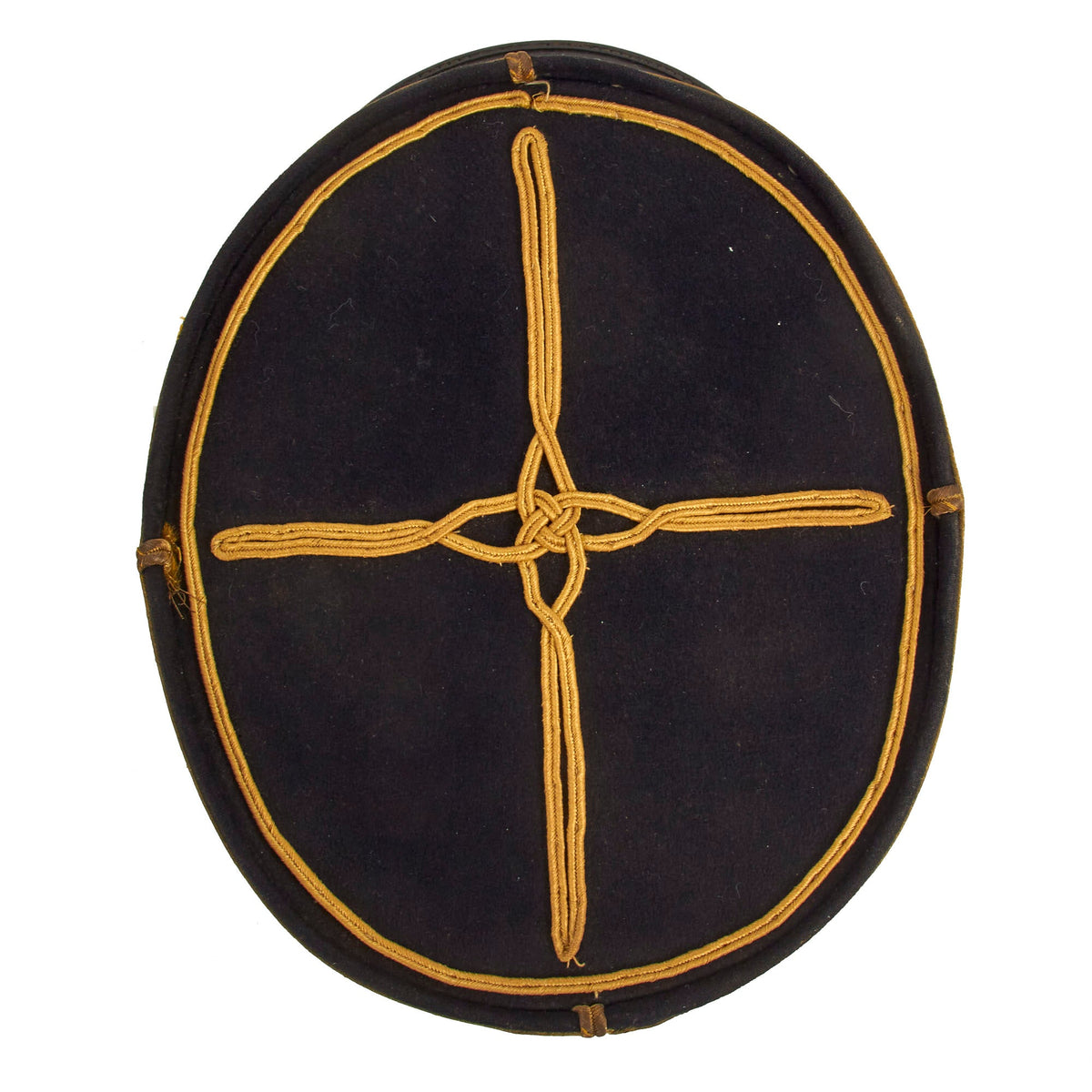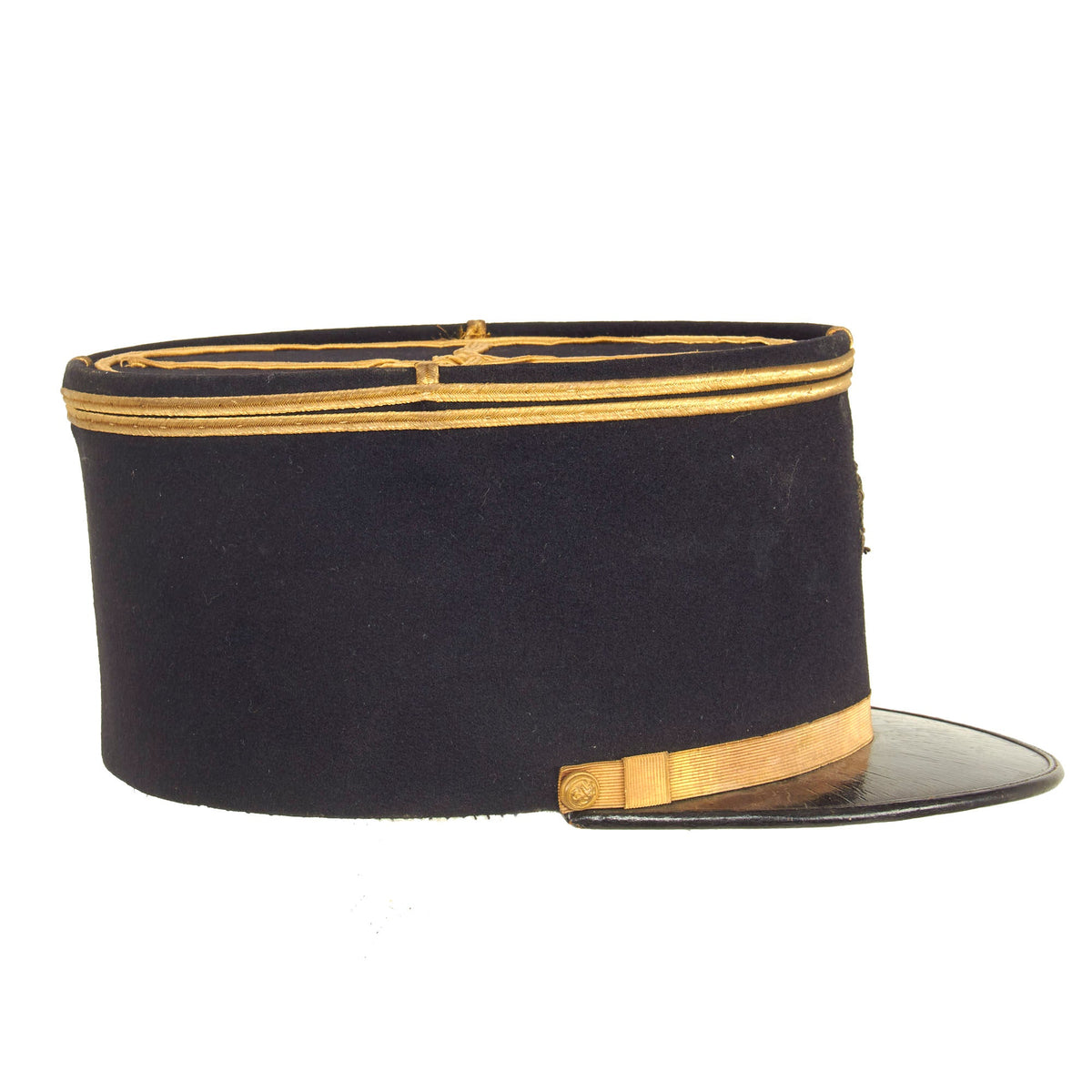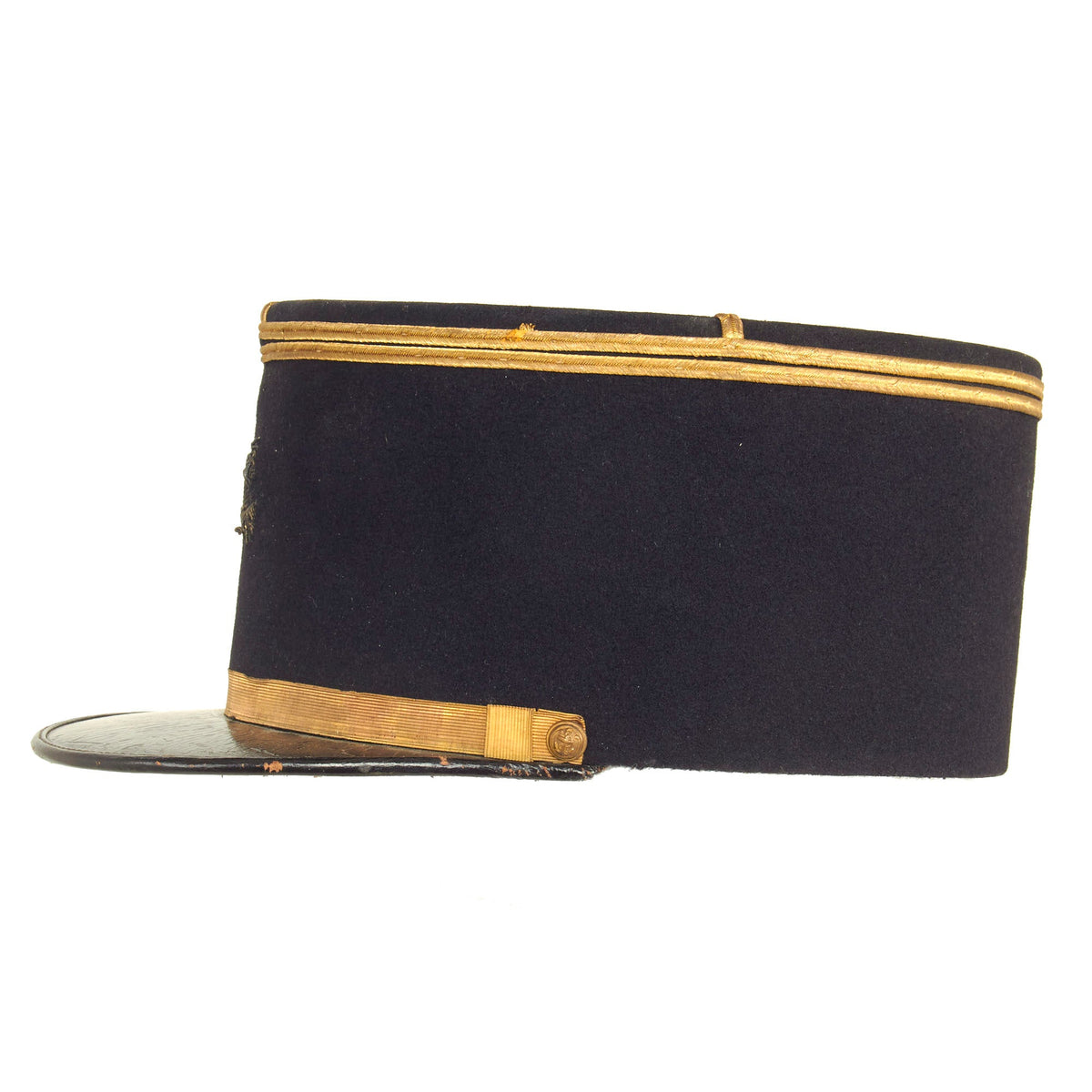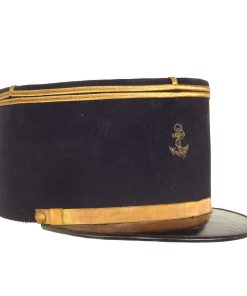Original French WWII Era French Troupes de Marine Colonial Navy Troops Kepi Original Items
$ 350,00 $ 105,00
Original Item: Only One Available. This is a fantastic example of a WWII era French Colonial Navy troops kepi. The kepi features an original bullion gold embroidered anchor insignia on the front. The kepi is all black felt with gold bullion trim and braid. This is one of the nicest examples from this era we have had to offer!
The kepi is a cap with a flat circular top and a peak, or visor. In English, the term is a loanword of French: képi, itself a re-spelled version of the Alemannic German: Käppi, a diminutive form of Kappe, meaning “cap”. In Europe, this headgear is most commonly associated with French military and police uniforms, though versions of it were widely worn by other armies during the late 19th and early 20th centuries. In North America, it is usually associated with the American Civil War, as it was worn by soldiers on both sides of the conflict.
This example is offered in wonderful, complete condition. It appears to be in original configuration and shows very little signs of use and wear. The black leather liner unfortunately suffered some stitching loss and is now partially detached.
A wonderful example ready for further research and display.
The Troupes coloniales (“Colonial Troops”) or Armée coloniale (“Colonial Army”), commonly called La Coloniale, were the military forces of the French colonial empire from 1900 until 1961. From 1822 to 1900 these troops were designated Troupes de marine (“Marine Troops” or just “Marines”), and in 1961 they readopted this name. They were recruited from mainland France or from the French settler and indigenous populations of the empire. This force played a substantial role in the conquest of the empire, in World War I, World War II, the First Indochina War and the Algerian War.
From 1822 to 1900 these troops, both French and indigenous, had been designated as Troupes de Marine, though they were not directly linked to the French Navy. Both services were however administered by the Ministre de la Marine and shared an anchor badge. This insignia continued to be worn after the Troupes de la Marine became the Troupes Coloniales in 1900 and photographs of mehariste (camel corps) troopers taken in the 1950s show anchor badges even in the Mauritanian desert far from the sea. In 1961 the title of Troupes de Marine was readopted after a brief period (1958–61) as Troupes d’Outre-Mer (Overseas Forces).
The Troupes de Marine (TDM, lit. ’Marine Troops’) is a corps of the French Army that includes several specialties: infantry, artillery, armored, airborne, engineering, and transmissions (Signals). Despite its name, it forms part of the Army, not the Navy. Intended for amphibious and overseas operations, the Troupes de marine have been, and still are, in all the fights of the French army. It has gradually become professionalized since 1970.
By the time the Troupes were transferred to the Army the unit names changed from “Marine” to “Colonial” while the Fusiliers-Marins remained part of the French Navy. The Troupes Coloniale were still used in occasional amphibious landings but this was because of the ready availability of units normally based near naval embarkation ports or in colonial garrisons. In the World War I Gallipoli campaign in the Dardanelles, the Corps expéditionnaire d’Orient was more than two-thirds Troupes Coloniale including the 4th, 6th, 7th and 8th Colonial Infantry Regiments and Colonial Artillery. (The artillery element at Gallipoli did not contain any artillery units from the Troupes Coloniales.) The Troupes Coloniales were however far more likely to see action in African or Asian land campaigns or, during both World Wars, in France itself.
In World War II, one Colonial unit did have “Marine” in its title – The Bataillon d’Infanterie de Marine du Pacifique (BIMP). Two divisions of the Troupes Coloniale were trained in amphibious tactics by the Americans and performed amphibious landings at Corsica (6th Moroccan Mountain Division) and Elba (9th Colonial Infantry Division – 9e DIC). Both these divisions also landed in southern France in the follow-on echelons of Operation Dragoon. The French wanted the United States to transport these two divisions to the Pacific to fight against the Japanese and later retake French Indochina, but transport was a problem.
The Troupes colonials distinguished themselves in both World Wars. The most decorated regimental colors of the French Armed Forces are those of the Colonial Infantry Regiment of Morocco (RICM) and the regimental colors of the 2nd Marine Infantry Regiment 2e RIMa. After 1945 the decolonization wars involved the colonial troops in Indochina, Algeria, and Madagascar. Following 1962, operations in Africa were undertaken by the again renamed troupes de Marine and the Légion étrangère which were the only units mainly or entirely composed of “engaged” (non-conscript) soldiers. This was also the case in Tchad and in Lebanon and the former Yugoslavia before metropolitan troops started also to recruit volunteer soldiers. The cessation of obligatory military service after 2001 permitted the deployment of the remainder of the French Army in overseas operations.
Fast Shipping with Professional Packaging
Thanks to our longstanding association with UPS FedEx DHL, and other major international carriers, we are able to provide a range of shipping options. Our warehouse staff is expertly trained and will wrap your products according to our exact and precise specifications. Prior to shipping, your goods will be thoroughly examined and securely secured. We ship to thousands clients each day across multiple countries. This shows how we're dedicated to be the largest retailer on the internet. Warehouses and distribution centres can be located throughout Europe as well as the USA.
Note: Orders with more than one item will be assigned a processing date depending on the item.
Before shipping before shipping, we'll conduct a thorough inspection of the items you have ordered. Today, the majority of orders will be delivered within 48 hours. The delivery time will be between 3-7 days.
Returns
The stock is dynamic and we cannot completely manage it because multiple stakeholders are involved, including our factory and warehouse. So the actual stock may alter at any time. It's possible that you may not receive your order once the order has been made.
Our policy is valid for a period of 30 days. If you don't receive the product within 30 days, we are not able to issue a refund or an exchange.
You can only return an item if it is unused and in the same state as the day you received it. You must have the item in its original packaging.
Related products
Uncategorized
Uncategorized
Uncategorized
Uncategorized
Uncategorized
Uncategorized
Uncategorized
Uncategorized
Uncategorized
Uncategorized
Uncategorized
Uncategorized
Uncategorized
Uncategorized
Band of Brothers ORIGINAL GERMAN WWII Le. F.H. 18 10.5cm ARTILLERY PIECE Original Items
Uncategorized
Uncategorized
Australian WWII Owen MK1 Machine Carbine SMG Custom Fabricated Replica with Sling Original Items
Uncategorized
Uncategorized
Uncategorized
Armoured Fighting Vehicles of the World: AFVs of World War One (Hardcover Book) New Made Items

